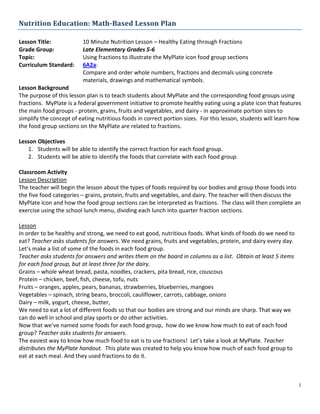
Late Elementray Nutrition Lesson Fractions Final. E. Madison
- 1. Nutrition Education: Math-Based Lesson Plan Lesson Title: 10 Minute Nutrition Lesson – Healthy Eating through Fractions Grade Group: Late Elementary Grades 5-6 Topic: Using fractions to illustrate the MyPlate icon food group sections Curriculum Standard: 6A2a: Compare and order whole numbers, fractions and decimals using concrete materials, drawings and mathematical symbols. Lesson Background The purpose of this lesson plan is to teach students about MyPlate and the corresponding food groups using fractions. MyPlate is a federal government initiative to promote healthy eating using a plate icon that features the main food groups - protein, grains, fruits and vegetables, and dairy - in approximate portion sizes to simplify the concept of eating nutritious foods in correct portion sizes. For this lesson, students will learn how the food group sections on the MyPlate are related to fractions. Lesson Objectives 1. Students will be able to identify the correct fraction for each food group. 2. Students will be able to identify the foods that correlate with each food group. Classroom Activity Lesson Description The teacher will begin the lesson about the types of foods required by our bodies and group those foods into the five food categories – grains, protein, fruits and vegetables, and dairy. The teacher will then discuss the MyPlate icon and how the food group sections can be interpreted as fractions. The class will then complete an exercise using the school lunch menu, dividing each lunch into quarter fraction sections. Lesson In order to be healthy and strong, we need to eat good, nutritious foods. What kinds of foods do we need to eat? Teacher asks students for answers. We need grains, fruits and vegetables, protein, and dairy every day. Let’s make a list of some of the foods in each food group. Teacher asks students for answers and writes them on the board in columns as a list. Obtain at least 5 items for each food group, but at least three for the dairy. Grains – whole wheat bread, pasta, noodles, crackers, pita bread, rice, couscous Protein – chicken, beef, fish, cheese, tofu, nuts Fruits – oranges, apples, pears, bananas, strawberries, blueberries, mangoes Vegetables – spinach, string beans, broccoli, cauliflower, carrots, cabbage, onions Dairy – milk, yogurt, cheese, butter, We need to eat a lot of different foods so that our bodies are strong and our minds are sharp. That way we can do well in school and play sports or do other activities. Now that we’ve named some foods for each food group, how do we know how much to eat of each food group? Teacher asks students for answers. The easiest way to know how much food to eat is to use fractions! Let’s take a look at MyPlate. Teacher distributes the MyPlate handout. This plate was created to help you know how much of each food group to eat at each meal. And they used fractions to do it. 1
- 2. They divided the plate into four sections. Each section is a certain fraction. Once you know the fraction of each section on the plate, it is easy to know how much to eat at each meal. Let’s look at each section: Fruits – in terms of fractions, how much does the fruit portion take up on the plate? ¼. Vegetables - how much do vegetables comprise? ¼. Grains – how big of a section do grains have? Approximately ¼. Protein – how much room does protein take up on the plate? Approximately ¼ . So each section comprises approximately ¼ of the plate. The dairy is by itself so we don’t count it on the plate. Now, we see that fruits and vegetables each take up ¼ of the plate. So how much do they take up together? ½. That’s a lot. We need a lot of fruits and vegetables because they give us energy, vitamins, minerals and water. They’re also low in calories so they are a healthy choice. So each meal you eat should contain a plate that is half full of fruits and vegetables. So now we know that when we eat, our plates should be ½ fruits and vegetables, ¼ protein and ¼ grains. Remember that 4 quarters (¼s) equal one whole. And with my plate, that means you are getting complete nutrition for your body, so make sure plate has 4 ¼s that add up to a whole lot of nutrition! Now let’s put these fractions into action. Activity Let’s look at the lunch menu. Teacher distributes 1) current elementary lunch menu to students. One week will be used for the activity; 2) 5 copies of Black and White MyPlate worksheets. The teacher instructs the students to fit each lunch meal into a MyPlate so they can observe how the lunch meal is also divided into quarters. See example below. Chilled Pears - 1/4 Skim Milk Bun – 1/4 Seasoned Peas & Carrots 1/4 Cheeseburger - 1/4 Closing Now that we’ve observed that the school lunch menu matches the fraction composition we discussed, you will be able to observe if your meals outside school matches these fractions. Cafeteria Connection The students will make the meal they buy match the MyPlate icon. Their ability to do so can be discussed the following day and once a week until they become comfortable with the food group portions. Home Activity The students can be asked to match the meals they eat at home to the MyPlate and report back to the class what food groups, if any, were missing or if the food group portions were too big or too small. 2
